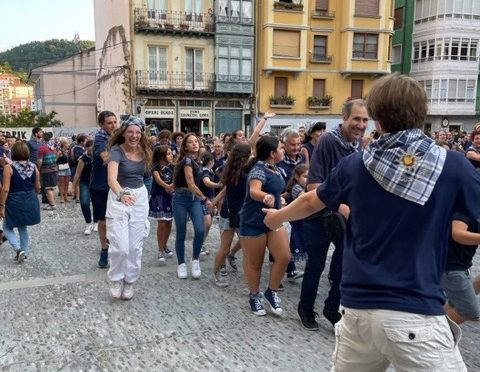One of the most memorable parts of my time living in the Basque Country was the fiestas. There simply is no equivalent in the United States – throngs of people cramming the streets, drinking, eating, and singing until the wee hours of the morning. That the Basques have a phrase for spending all night out – gau pasa – is telling. By coincidence, the day after we arrived in Bermeo was the fiesta de las Madalenas. While we didn’t stay up until dawn, it was still a great opportunity to introduce my family and friends to a Basque festa. But, before that, we had to go to Aritzatxu beach and get a little time in the ocean.

- The Madalanas commemorates the resolution of a dispute over the island of Izaro. Izaro lies in the Cantabrian Sea about 2 kilometers (1.25 miles) from Mundaka and 3 (nearly 2 miles) from Bermeo. It is a small island, only about 650 meters or 2100 feet long. Back in 1422, the Franciscans established a convent on the island. There were also hermitages dedicated to Clara and Magdalena. In 1596, while the Bizkaian fleet was otherwise occupied, Francis Drake and his fleet of 14 ships attacked the island. The convent subsequently fell into ruin.
- The island had been a source of constant dispute between the towns of Bermeo, Elantxobe, and Mundaka, a dispute that even reached the Juntas Generales of Bizkaia. However, legend tells that the dispute was settled peacefully, through a rowing contest, or regatta.
- According to the story, Mundaka and Bermeo raced to see who would control the island. Elantxobe had already given up its claim and instead acted as arbitrator for the race. At dawn, the two crews left their respective ports for the island of Izaro. Bermeo won the race, despite losing a rower who fell into the sea. Mundaka claimed that Bermeo cheated: the race was to begin at dawn and the people of Bermeo supposedly tricked their roosters to crow early by lighting bonfires. Another story says that the Bermeo sailors got those from Mundaka drunk the night before.
- The contest and Bermeo’s win are celebrated every July 22, the day of Saint Magdalena. The mayor of Bermeo leaves the port with a fleet of boats for Izaro, where he or she throws a tile into the water to recognize Bermeo’s claim to the island. The tile is meant to represent the fact that the roofs of Bermeo reach that far. The mayor then travels by water to Elantxobe and then Mundaka, where the Bermeo mayor is even given power for a few hours. Ultimately, the fleet returns to Bermeo, to much dancing and singing in the streets, particularly in the Goiko Plaza.
- There is no historical record of this race and it has to be chalked up to legend and the storytelling of sailors. But that the three towns were able to come to a peaceful resolution of this dispute and celebrate it together is pretty cool.
Primary sources: Arozamena Ayala, Ainhoa. Izaro. Auñamendi Encyclopedia. Available at: https://aunamendi.eusko-ikaskuntza.eus/en/izaro/ar-56693/; The Festival of Las Magdalenas (Bermeo, Elantxobe, and Mundaca), Fascinating Spain; La fiesta de Madalenas: Bermeo, Elantxobe y Mundaka, UrdaiLife


